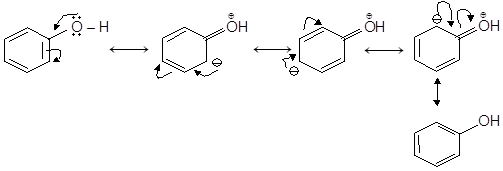Acidity of Phenols
Acidity of Phenols
Although Phenols are structurally similar to alcohols, they are much stronger acids. But phenol is a weak acid when compared to a carboxyllic acid, such as acetic acid
(pKa = 4.7447).
The greater acidity of phenol owes itself primarily to an electrical charge distribution in phenols that causes the –OH oxygen to be more positive; therefore the proton is held less strongly.
The factor influencing the electron distribution may be the contributions to the overall resonance hybrid of phenol made by the resonance structures shown below. The effect of these structures is to withdraw electrons from the hydroxyl group and to make the oxygen positive. Check out Chemistry Formulas and NCERT Solutions for class 11 Chemistry prepared by Physics Wallah.

The considerably greater acid strength of PhOH (pKa = 10) than that of ROH (pKa = 18) can be accounted for as the negative charge on the alkoxide anion, RO–, cannot be delocalized, but on PhO– the negative charge is delocalized to the ortho and para ring positions as indicated by the starred sites in the resonance hybrid.

PhO– is therefore a weaker base than RO–, and PhOH is a stronger acid the effect of
a) electron – attracting and
-
electron – releasing substituents on the acid strength of phenols
- Electron–attracting substituents disperse negative charges and therefore stabilize ArO– and increase acidity of ArOH. Electron – releasing substituents concentrate the negative charge on O destabilizes ArO– and decreases acidity of ArOH.
In terms of resonance and inductive effects we can account for the following relative acidities.
- p-O2NC6H4OH > m–O2NC6H4OH > C6H5OH
- m–ClC6H4OH > p-ClC6H4OH > C6H5OH
a) The–NO2 is electron–withdrawing and acid–strengthening. Its resonance effect, which occurs only from para and ortho positions, predominates over its inductive effect, which occurs also from the meta position.
c) Cl is electron – withdrawing by inductive. This effect diminishes with increasing distance between Cl and OH. The meta is closer than the para positions and m-Cl is more acid – strengthening than the p-Cl. Other substituents in this category are F,Br, I, +NR3.
Recent Concepts
- How to calculate equivalent weight ?
- What is equivalent weight of oxalic acid
- Atomic weight of elements
- What is Limiting Reagents ?
- Molarity
- Define back bonding in BF3
- Heisenberg's Uncertainty Principle
- What are Inert pair effects
- Quantum Numbers
- What is the boron trifluoride formula?
- What is the Structure of orthoboric acid ?
- What is the Structure of Borax ?
- What is the structure of diboranes ?
- LiAlH4 Reaction and Mechanism
- Grignard reagent and its application in organic reactions
- How Haloform reaction proceed ?
- What is Oxirane ?
- Acidity of Phenols
- Explain the mechanism of Bromination of Phenol
- what is a chemical reaction?









